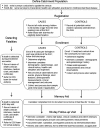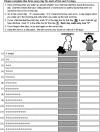The Global Enteric Multicenter Study (GEMS) of diarrheal disease in infants and young children in developing countries: epidemiologic and clinical methods of the case/control study
- PMID: 23169936
- PMCID: PMC3502307
- DOI: 10.1093/cid/cis753
The Global Enteric Multicenter Study (GEMS) of diarrheal disease in infants and young children in developing countries: epidemiologic and clinical methods of the case/control study
Erratum in
- Clin Infect Dis. 2013 Jul;57(1):165
Abstract
Background: Diarrhea is a leading cause of illness and death among children aged <5 years in developing countries. This paper describes the clinical and epidemiological methods used to conduct the Global Enteric Multicenter Study (GEMS), a 3-year, prospective, age-stratified, case/control study to estimate the population-based burden, microbiologic etiology, and adverse clinical consequences of acute moderate-to-severe diarrhea (MSD) among a censused population of children aged 0-59 months seeking care at health centers in sub-Saharan Africa and South Asia.
Methods: GEMS was conducted at 7 field sites, each serving a population whose demography and healthcare utilization practices for childhood diarrhea were documented. We aimed to enroll 220 MSD cases per year from selected health centers serving each site in each of 3 age strata (0-11, 12-23, and 24-59 months), along with 1-3 matched community controls. Cases and controls supplied clinical, epidemiologic, and anthropometric data at enrollment and again approximately 60 days later, and provided enrollment stool specimens for identification and characterization of potential diarrheal pathogens. Verbal autopsy was performed if a child died. Analytic strategies will calculate the fraction of MSD attributable to each pathogen and the incidence, financial costs, nutritional consequences, and case fatality overall and by pathogen.
Conclusions: When completed, GEMS will provide estimates of the incidence, etiology, and outcomes of MSD among infants and young children in sub-Saharan Africa and South Asia. This information can guide development and implementation of public health interventions to diminish morbidity and mortality from diarrheal diseases.
Figures


References
-
- United Nations Inter-agency Group for Child Mortality Estimation. Levels and Trends in Child Mortality Report 2011. Available at: http://www.unicef.org/media/files/Child_Mortality_Report_2011_Final.pdf. Accessed 16 March 2012.
-
- You D, Wardlaw T, Salama P, Jones G. Levels and trends in under-5 mortality, 1990–2008. Lancet. 2010;375:100–3. - PubMed
-
- Anker M. The effect of misclassification error on reported cause-specific mortality fractions from verbal autopsy. Int J Epidemiol. 1997;26:1090–6. - PubMed
Publication types
MeSH terms
LinkOut - more resources
Full Text Sources
Other Literature Sources
Medical
Molecular Biology Databases

